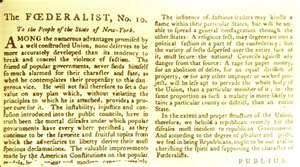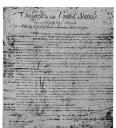Part 2: In Detail 
Possibly the most well-known essay is No. 10, published Nov. 23, 1787. In this essay, Madison sets out the idea that factions (read: political parties) will always result from the association of people with common interests and that the only way to keep such factions from taking over entirely is to limit their control. His argument is that by its very nature, a government that has the overall consent of the governed will find a way to protect itself from being taken over by one faction, no matter how strong that faction is: "The smaller the society, the fewer probably will be the distinct parties and interests composing it; the fewer the distinct parties and interests, the more frequently will a majority be found of the same party; and the smaller the number of individuals composing a majority, and the smaller the compass within which they are placed, the more easily will they concert and execute their plans of oppression. Extend the sphere, and you take in a greater variety of parties and interests; you make it less probable that a majority of the whole will have a common motive to invade the rights of other citizens; or if such a common motive exists, it will be more difficult for all who feel it to discover their own strength, and to act in unison with each other." The other main argument that Madison puts forward in this essay is that the Constitution sets out for the new United States a republic, not a democracy: Americans vote for other people to represent their concerns. This is especially true, though on a technicality, in the election of the President, who is elected through the Electoral College process by a group of people who are pledged to support "the will of the people." Madison echoes this idea in No. 14 (published Nov. 30, 1787): "… in a democracy, the people meet and exercise the government in person; in a republic, they assemble and administer it by their representatives and agents. A democracy, consequently, will be confined to a small spot. A republic may be extended over a large region." Madison's No. 14 also includes one of the most powerful and emotional arguments in favor of the Constitution and its theory of government: "But why is the experiment of an extended republic to be rejected, merely because it may comprise what is new? Is it not the glory of the people of America, that, whilst they have paid a decent regard to the opinions of former times and other nations, they have not suffered a blind veneration for antiquity, for custom, or for names, to overrule the suggestions of their own good sense, the knowledge of their own situation, and the lessons of their own experience? To this manly spirit, posterity will be indebted for the possession, and the world for the example, of the numerous innovations displayed on the American theatre, in favor of private rights and public happiness." 
One of the main points of contention during the Constitutional Convention was the idea that the Constitution itself did not enumerate or recognize a list of basic human rights. Part of the "Grand Compromise" that resulted in the adoption and ratification of the new frame of government was the implicit promise that it would eventually be accompanied by a Bill of Rights. (This was indeed the case, in the form of the first 10 Amendments.) Hamilton didn't see a need for such a codification and argued thus in The Federalist No. 84. Hamilton's argument, echoing the "social contract" ideas of John Locke, from whom Thomas Jefferson took inspiration in writing the Declaration of Independence, was that the entire Constitution represented a Bill of Rights in that it was by its very nature a compact between the government and the governed. One need look no further than the preamble, Hamilton said, for the protection of liberty and basic rights. Hamilton also argued that by making such a list could create the idea that no rights but those were protected. The Ninth Amendment addresses this concern: "The enumeration in the Constitution, of certain rights, shall not be construed to deny or disparage others retained by the people." One of the parts of the Constitution that is the most famous is the idea of "checks and balances," that, at the federal level, each of the three branches of government serves as a control against domination by the other two. The Federalist No. 51 (published Feb. 8, 1788) enunciates the theories behind and the reasons for this: "In the compound republic of America, the power surrendered by the people is first divided between two distinct governments, and then the portion allotted to each subdivided among distinct and separate departments. Hence a double security arises to the rights of the people. The different governments will control each other, at the same time that each will be controlled by itself." This essay, No. 51, is also notable for its often-quoted rhetorical question: "But what is government itself, but the greatest of all reflections on human nature?" For Jay's part, his contribution was largely on the topic of "Dangers from Foreign Force and Influence." In No. 2, Jay previews the "social contract" idea that runs through several of the subsequent essays: "Nothing is more certain than the indispensable necessity of government, and it is equally undeniable, that whenever and however it is instituted, the people must cede to it some of their natural rights in order to vest it with requisite powers." The more powerful argument that Jay advances in his four consecutive essays is that a united group of states will by its very nature have more power, more influence, more chance of success than a loose confederation of largely independent states. Given the very real possibility of war again with other nations, such a united front is necessary, Jay argues: "It is of high importance to the peace of America that she observe the laws of nations towards all these powers, and to me it appears evident that this will be more perfectly and punctually done by one national government than it could be either by thirteen separate States or by three or four distinct confederacies." Hamilton and Madison returned to this theme of union and concerted effort time and again in subsequent essays. The essays that make up The Federalist were intended, first and foremost, to convince the people of New York to vote to ratify the Constitution. Hamilton's efforts to publicize the arguments in other states, notably the largest, Virginia, are thought to have aided in the ratification by that state. The reality was, though, that by the time that New York ratified the Constitution, it was the 10th state to do so and the government framework was already the law of the land. Still, Federalists like Hamilton argued, having New York's approval was definitely a plus. It was certainly not altogether a foregone conclusion that each of the 13 Colonies would vote to replace one representative form of government with another, especially one that gave much power to the federal government, stoking the fears of many who had just fought a war against an oppressor. Modern historians now look to The Federalist as a powerful series of enunciations of the reasons for adopting republican government. First page > Defense of the New Form of Government> Page 1, 2 |
|
Social Studies for Kids
copyright 2002–2025
David White


